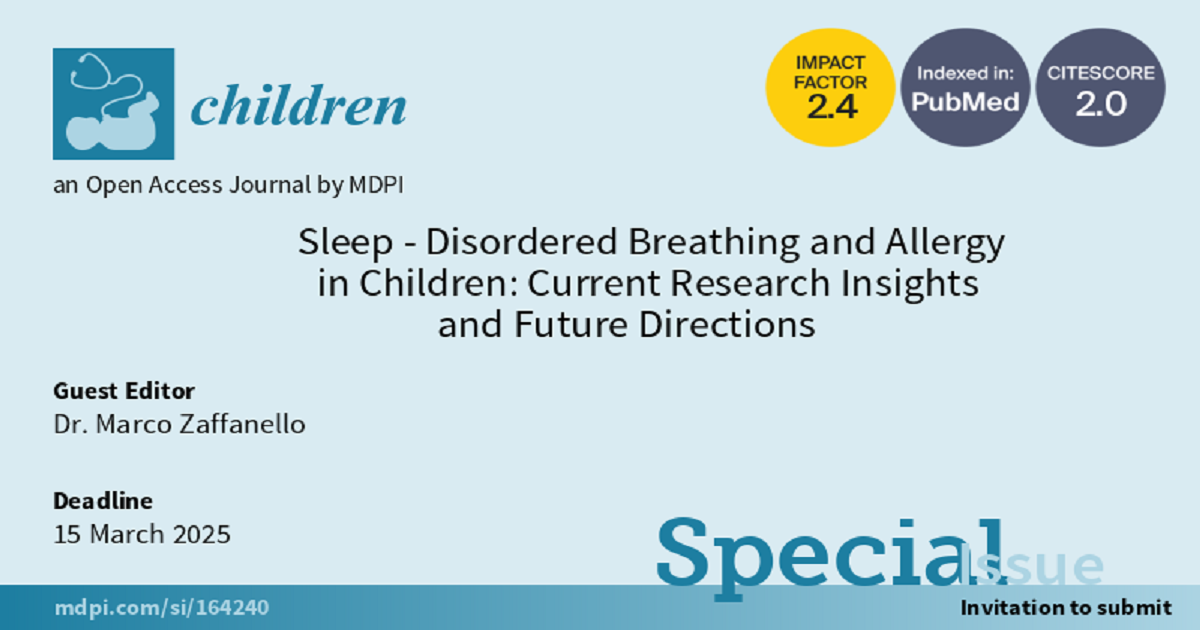- 2.1Impact Factor
- 3.8CiteScore
- 16 daysTime to First Decision
Sleep-Disordered Breathing and Allergy in Children: Current Research Insights and Future Directions
Special Issue Information
Dear Colleagues,
Sleep-disordered breathing (SDB) is a significant health problem worldwide. Among children, the prevalence of habitual snoring is 10% to 12%, while the prevalence of OSA is 1% to 3%. SDB encompasses a range of abnormal conditions with manifestations that range from simple snoring to potentially serious diseases, including OSA.
Sneezing, itching, a runny nose, and nasal congestion characterize allergic rhinitis. Atopy is considered a risk factor for habitual snoring. Furthermore, children with allergies have a higher risk for SDB or OSAS than non-allergic children. However, the severity of allergic rhinitis is significantly associated with the severity of OSAS. Additionally, allergic rhinitis, habitual snoring, and poor asthma control are important risk factors for SDB. Therefore, atopic children should receive additional attention for snoring and other features of OSAS.
The medical literature supports a proactive role for allergists in diagnosing and managing SDB. Although several studies have investigated the coexistence of OSA and inhalant allergy in standard clinical practice, the correlation has not been sufficiently clarified and investigated.
Dr. Marco Zaffanello
Guest Editor
Manuscript Submission Information
Manuscripts should be submitted online at www.mdpi.com by registering and logging in to this website. Once you are registered, click here to go to the submission form. Manuscripts can be submitted until the deadline. All submissions that pass pre-check are peer-reviewed. Accepted papers will be published continuously in the journal (as soon as accepted) and will be listed together on the special issue website. Research articles, review articles as well as short communications are invited. For planned papers, a title and short abstract (about 100 words) can be sent to the Editorial Office for announcement on this website.
Submitted manuscripts should not have been published previously, nor be under consideration for publication elsewhere (except conference proceedings papers). All manuscripts are thoroughly refereed through a single-blind peer-review process. A guide for authors and other relevant information for submission of manuscripts is available on the Instructions for Authors page. Children is an international peer-reviewed open access monthly journal published by MDPI.
Please visit the Instructions for Authors page before submitting a manuscript. The Article Processing Charge (APC) for publication in this open access journal is 2400 CHF (Swiss Francs). Submitted papers should be well formatted and use good English. Authors may use MDPI's English editing service prior to publication or during author revisions.
Keywords
- sleep-disordered breathing
- obstructive sleep apnea syndrome
- children
- inhalant allergy
- allergic rhinitis
- asthma

Benefits of Publishing in a Special Issue
- Ease of navigation: Grouping papers by topic helps scholars navigate broad scope journals more efficiently.
- Greater discoverability: Special Issues support the reach and impact of scientific research. Articles in Special Issues are more discoverable and cited more frequently.
- Expansion of research network: Special Issues facilitate connections among authors, fostering scientific collaborations.
- External promotion: Articles in Special Issues are often promoted through the journal's social media, increasing their visibility.
- e-Book format: Special Issues with more than 10 articles can be published as dedicated e-books, ensuring wide and rapid dissemination.

